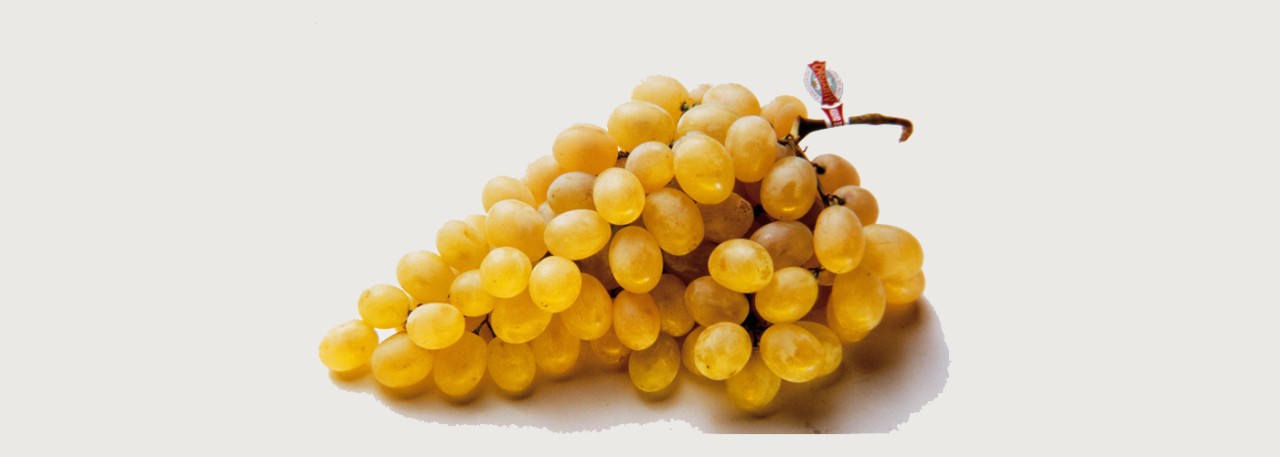.png.transform/rendition-xs/image_image%20(1).png)
Uva de Mesa Embolsada Vinalopó PDO
Victoria, Dominga, Doña María Aldeo, Ideal (or Italia) and Rosetti variety table white grapes, and Red Globe in black grapes. When harvesting begins, the grapes must have been permanently protected by a paper bag for a minimum of 60 days. The ‘Uva de Mesa Embolsada del Vinalopó’ maintains virtually all of its bloom, has a more accentuated colour and a skin which is free of defects.
Tasting notes
Grapes of the Ideal (or Italia) variety are crisp and juicy, with a pleasant Muscat flavor. Aledo grapes, on the other hand, have a very sweet taste once ripe.
Other notes
-White varieties:
Victoria grapes: the bunch is large, pyramid-shaped, and smaller at the bottom. The grape is a waxy-yellow colour and is large and elliptical in shape. The flesh is crisp, with a sweet neutral flavour. It endures transportation very well. It is grown on arbours and high espaliers. It may be harvested at the end of July and, where forcing methods are used, even in June. It is a variety which derives great advantages from being bagged, which provides protection from birds and insects and, above all, the bagging ensures quality produce. The variety tolerates it and good results are obtained. It is the very first variety being harvested.
Dominga grapes: may be harvested from October until the end of November. It is always bagged, resulting in very uniform cane-yellow tones and high quality, and it is very palatable to the consumer.
Doña María grapes: its bunches are large, conical in shape and very loose. Its berries are pale yellow in colour, very large and oval. Very sweet flavour. It ripens at the start of September until the end of October. It is grown on high arbours and double-cordoned high espaliers. The variety copes very well with bagging.
Aledo grapes: the bunches are large and loose. The grape is ellipsoidal in shape, and waxy-yellow in colour. Thick and crisp skin. Late ripening, from November to December.
Ideal grapes: the bunches are medium-sized, with large berries which are golden-yellow in colour and elliptical in shape, with crisp flesh and a slight flavour of Muscat. Harvesting takes place from September to October.
Rosetti grapes: the bunches are large and cylindrical-conical or pyramidal in shape. The berries are waxy-yellow to golden-yellow in colour. The grape is large, with a neutral flavour but very sweet, with crisp flesh. Its skin is fine, with a pruinose consistency. Harvesting takes place from the beginning of September to the end of October.
-Black varieties:
Red Globe Grapes: its bunches are very large, conical-cylindrical, winged, with medium to long wings, and semi-loose. Its berries may be red, red-wine coloured, pink or red-violet coloured, spherical in shape, very large, with a neutral flavour, crisp flesh, and skin which is thick, resistant and easy to peel. It is grown on high arbours and double-cordoned high espaliers. It is a variety which has adapted perfectly to the conditions of the region and to bagging.
These varieties are characterised by a high degree of sweetness, with a minimum of 12,5º Brix.
There are two categories: Extra and Class I. The fruit which belongs to them must be:
-sound,
-clean,
-free of any foreign matter,
-free from signs of damage by pests or diseases,
-free from all visible traces of mould,
-free of abnormal external moisture,
-free of foreign smell and/or taste.
Individual grapes must be:
-well formed,
-normally developed,
-attached to the stalk.
Production / Processing method
The bagging of the table grape is a special technique which is carried out ‘exclusively’ in the Mid Vinalopó area, in the abovementioned municipalities. This practice began in the municipality of Novelda around 1920, in order to protect the bunches against the bunch moth by using paper ‘bags’. It consists of placing each bunch inside a protective paper bag where it remains until it is packaged.
Selecting the right paper has been highlighted: the paper used, which is made of long cellulose fibres containing melanine to protect against humidity, and is satiny and cane-coloured, is also partly responsible for the stronger colour of the grapes. This paper also lasts longer and repels more rainwater, which helps prevent the berries from developing skin defects, although it can lead to some grapes at the top of the bunch burning if temperatures are very high when the bag is placed on the bunch. Knowledge of the climatology of the area is fundamental for carrying out bagging correctly.
The PDO ‘Uva embolsada del Vinalopó’ maintains virtually all of its bloom. Its berries are distinctive as they have a more accentuated colour and a skin which is free of defects. ‘Uva de Mesa Embolsada del Vinalopó’ has distinctive features arising from a combination of natural and human factors.
Geography / Relief and climate
The Mid Vinalopó area is a meeting point for three climate types which, as part of the Mediterranean climate, originate in the province of Alicante (maritime, temperate and sub-tropical).
This means that the region rarely has temperatures lower than 0 °C, with the greatest risk of frost existing in the low areas facing north and north-west.
There are stark contrasts in terms of precipitation: both droughts and floods, and also a great level of variation in precipitation patterns from one year to the next, as well as in periods of drought.
The soil is limey and its lithology includes terraced gravel deposits resulting from continental sediments, marine sediments, molasses and limestone and arsenic and limey marls. All the soils in the Valley have a high calcium carbonate content and low levels of organic materials.
The topography of the region is conditioned by the Vinalopó and adjacent valleys which make up a narrow NE-SE passageway which cuts across the slope of the ‘Prebético’ mountain range through which the River Vinalopó flows.
The protected area has a Mediterranean climate, whose gentle temperatures throughout the year endow the berries with a more accentuated colour.
The topography of the Vinalopó district, which is characterised by interconnected valleys forming a passageway, keeps it free from frosts and thereby helps the fruit to obtain a stronger colour.
Regulatory Council
Consejo Regulador de la DOP Uva de Mesa Embolsada Vinalopó
Virgen del Remedio, 33
03660 Novelda (Alicante)
Tel: (+34) 965 604 859
info@uva-vinalopo.org
www.uva-vinalopo.org
Sources:
The bagging of the table grape consists of placing each bunch inside a protective paper bag where it remains until it is packaged.


- /content/dam/en/icex-foodswines/images/products/fruits---vegetables/uva-de-mesa-embolsada-vinalopó-pdo/Uva%20de%20Mesa%20Embolsada%20Vinalopó%20PDO%20carr1.jpg
- /content/dam/en/icex-foodswines/images/products/fruits---vegetables/uva-de-mesa-embolsada-vinalopó-pdo/Uva%20de%20Mesa%20Embolsada%20Vinalopó%20PDO%20carr2.jpg

Novelda (Valencian Community)
